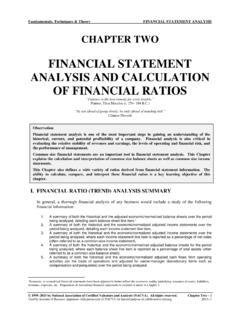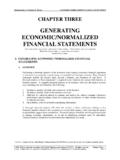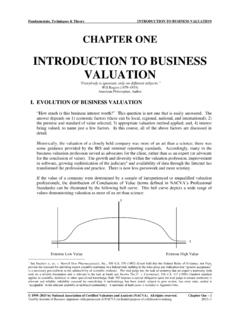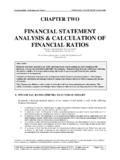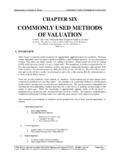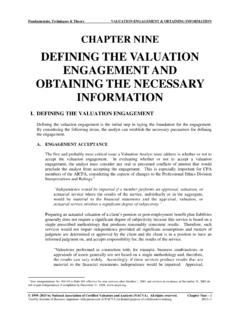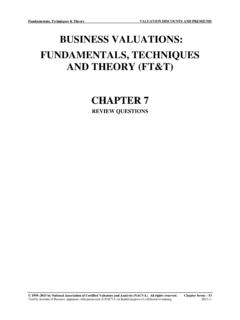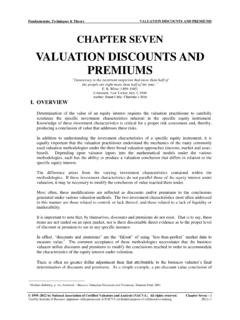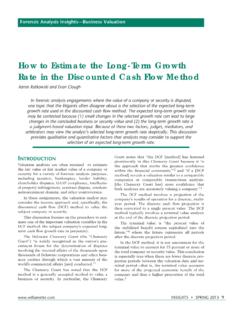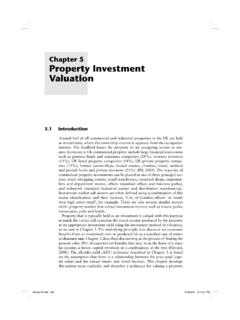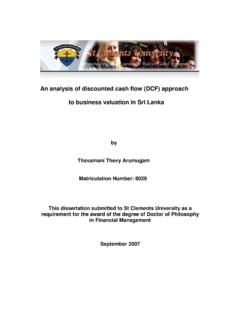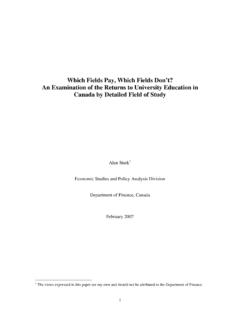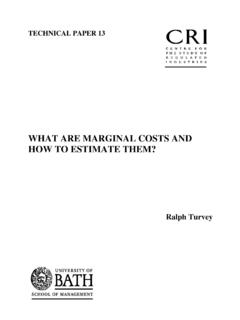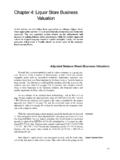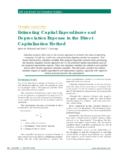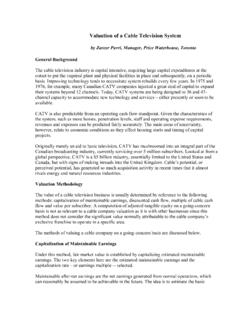Transcription of DEFINING AND ESTIMATING THE FUTURE …
1 Fundamentals, Techniques & Theory DEFINING AND ESTIMATING THE FUTURE BENEFIT STREAM 1995 2015 by National Association of Certified Valuators and Analysts (NACVA). All rights reserved. Chapter Four 1 Used by Institute of Business Appraisers with permission of NACVA for limited purpose of collaborative training. CHAPTER FOUR DEFINING AND ESTIMATING THE FUTURE BENEFIT STREAM Business without profit is not business anymore than a pickle is a candy. Charles F. Abbott After completing the financial analysis of the company, normalizing the historical earnings, analyzing the economic and industry conditions and forecasts and evaluating the internal and external risk factors of the company, the analyst is in a position to derive the estimate or conclusion of value.
2 The following issues are addressed to derive estimate or conclusion of value: How will we define and measure the FUTURE benefit stream to be used in valuing the company? Will we use historical or projected economic income to estimate or project the FUTURE benefit stream? Will we be projecting FUTURE benefits to equity, or to the entire company (invested capital)? I. DEFINING AND MEASURING THE FUTURE BENEFIT STREAM To answer the first question above, the valuation analyst will consider the following: A. NATURE OF BUSINESS INTEREST BEING VALUED; CONTROLLING VS. NON-CONTROLLING The type of benefits may depend on the nature of the interest being valued.
3 The estimated FUTURE benefit stream may be representative of a controlling interest benefit stream or a non-controlling interest benefit stream. The analyst must understand the correlation between the nature of the interest and the corresponding benefit stream. Capitalizing or discounting a controlling interest benefit stream will result in a controlling interest value. Correspondingly, capitalizing or discounting a non-controlling interest benefit stream will result in a non-controlling interest value. Practice Pointer In this chapter, we will discuss the following: Selecting and measuring the type of FUTURE benefits to be valued Distinguishing cash flows to equity from cash flows to invested capital Forecasting FUTURE economic benefits DEFINING AND ESTIMATING THE FUTURE BENEFIT STREAM Fundamentals, Techniques & Theory 2 Chapter Four 1995 2015 by National Association of Certified Valuators and Analysts (NACVA).
4 All rights reserved. Used by Institute of Business Appraisers with permission of NACVA for limited purpose of collaborative training. Further, the type of benefits may depend on whether the nature of the interest being valued is an equity interest, invested capital, intangible asset, tangible asset, etc. The type of benefit needs to correspond to the interest having access to the benefit. For example: 1. Net cash flow to equity will result in the value of the equity 2. Net cash flow to invested capital will result in the value of the invested capital B. PURPOSE OF THE VALUATION The type of benefits is often defined or suggested, based on the purpose of the valuation (refer to the various purposes of valuations discussed in Chapter One).
5 It is often the case that the parties seeking the valuation define the type of benefits to be used in a valuation. Such would be the case if you were asked to estimate the value of a business based on an established buy-sell agreement which defined the type of earnings to be employed in the valuation. For litigation purposes, state law may define the type of benefits . For transactional purposes, the type of benefits may be defined by parameters used to develop the market multiples. C. METHOD USED TO SUPPORT THE ESTIMATE OR CONCLUSION OF VALUE In some cases the type of earnings is defined by the method used in ESTIMATING the value of the business (see Chapter Six).
6 For example, the type of earnings used with the Price Earnings Ratio Method or the Dividend Paying Capacity Method is the net income of the company. When using the Capitalization of Earnings Method or Excess Earnings Return on Assets over Reasonable Rate Method, the type of earnings used could be either net cash flow to equity, net income before tax or net income after-tax, as long as your capitalization rate is consistent with the type of earnings used. The type of earnings generally used in the Discounted Economic Income Method (also referred to as the Discounted FUTURE Earnings or Discounted Cash Flows) is Net Cash Flow to Equity or Net Cash Flow to Invested Capital.
7 Net Income Before Tax or Net Income After-tax is usually the type of earnings used with the Excess Earnings Return on Assets (Treasury Method) as long as the rate of return on assets is based on the same type of earnings. For example, if the rate of return on assets is based on Net Income Before Taxes, then the valuator should use the same type of earnings. D. NET CASH FLOWS VS. GAAP EARNINGS When using an income approach, some valuators prefer net cash flows as the type of earnings to use as a measurement of economic income. The reasons net cash flows are generally preferred are: 1. Net cash flows represent the type of earnings most investors are seeking and expect to receive from their investments.
8 2. Most of the cost of capital derived from the capital markets and other empirical data that is used to derive the discount rate represents net cash flows as the type of earnings to measure economic income. For example, the data used in the Ibbotson Build-up Method to derive the discount rate is based on net cash flows as the measurement of economic income. Fundamentals, Techniques & Theory DEFINING AND ESTIMATING THE FUTURE BENEFIT STREAM 1995 2015 by National Association of Certified Valuators and Analysts (NACVA). All rights reserved. Chapter Four 3 Used by Institute of Business Appraisers with permission of NACVA for limited purpose of collaborative training.
9 3. Net cash flows bring into the income approach the expected FUTURE changes in the balance sheet. Net cash flows will take into consideration the FUTURE expected working capital needs, capital expenditures, and changes in long-term debt necessary to support the projected earnings of the company. GAAP earnings (or net income) are sometimes used as the type of benefits to measure economic income when the valuation analyst expects the FUTURE earnings will approximate the FUTURE net cash flows. Normally, this will be the case when the capital expenditures, net working capital requirements and changes in long-term debt to support the company s projected operations are insignificant in relationship to the earnings.
10 In addition, even when capital expenditures are significant, this will be the case when depreciation expense approximates capital expenditures. When determining whether to use net cash flows or net income, the analyst needs to carefully analyze the FUTURE expected trend in earnings and cash flows. The analyst must determine the FUTURE working capital needs, capital expenditures, and borrowings and repayments of long-term debt to support the expected FUTURE operations in order to determine the economic benefits available to the equity holder. If earnings are used, the analyst needs to explain in the report why he/she expects the FUTURE earnings will approximate the FUTURE cash flows of the company.
